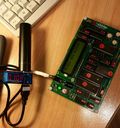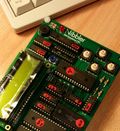In Ocotober 2015, NTT Docomo was the first network operator who has started VoLTE Roaming based on a pre-standard implementation of the S8 Home Routing (S8HR) concept. I wrote about it at the time and speculated how they might have implemented the service as there was little official technical documentation available. In the meantime, 3GPP has continued their investigation of what is necessary to fully standardize the S8-HR concept and the details can be found in Technical Report (which is not a specification, it's just a report) TR 23.749 for 3GPP Release 14 (!). In December 2015, version 1.0.0. of the document was published that contains a number of interesting insights into what is already available and what is still missing in the specifications depending on which features an operator wants to use for VoLTE S8HR Roaming.
Dedicated Bearers for voice packets possible: At the time I wrote that if a network operator wants to play things purely on his own, VoLTE Roaming can be deployed without any interaction with the visited network operator except for the need, of course, to have a general LTE roaming requirement in place. If some more cooperation between home and visited network is put in place it is even possible to assign a dedicated bearer for voice packets by the IMS system in the home network to prefer voice packets in the network and especially on the air interface.
As shown in TR 23.749 in figure 4-2.1 this works without any additional specification work as the PCRF (Packet Control Resource Function) in the home network is told by the VoLTE IMS system in the home network to establish a dedicated bearer. The PCRF then talks to the Packet Gateway (P-GW) in the home network which in turn forwards the request to the Serving Gateway (S-GW) in the visited network. From there it goes to the LTE base station (eNodeB) and from there to the mobile device. In principle it is the same message flow as in a non-roaming scenario but the roaming interconnect has to let such configuration messages pass between P-GW and S-GW. The big advantage of the approach is that the VoLTE client on the mobile device does not have to behave differently when roaming abroad, i.e. there is no need for it to decide whether it has to wait for a dedicated bearer for the voice packets or not before proceeding the call.
Single Radio Voice Call Continuity: One of the main drawbacks off S8-HR VoLTE roaming that it is more difficult to put a mechanism in place to switched over from an IP-based LTE bearer to a circuit switched 2G or 3G channel at the edge of LTE coverage. TR. 23.749 points out that from an architectural point of view, no additional specifications are necessary for SR-VCC to work across borders in a Release 8 SR-VCC configuration. I presume, however, that quite a number of network operators have already gone to a post-Release 8 SR-VCC implementation in the network which has a number of additional components to speed up the process. For this setup, SR-VCC across borders is not possible with the current specification. Interestingly enough the 3GPP technical report excludes discussions of potential solutions from the document. In other words, it seems to be complicated enough to be put into a separate TR. It would be interesting to know of Docomo has actually implemented SR-VCC for their S8HR VoLTE roaming with Korea or if they just went ahead without it as LTE coverage is said to be pretty much deployed everywhere in Korea in the meantime anyway so there's no need for it in the first place.
There are two other topics discussed in the technical report, how emergency calls could be made properly and how to best signal to the VoLTE IMS system that the device is not at home but roaming in another country. Falling back to 2G or 3G cellular for emergency calls is a quick and working solution but the report also gives some details of how it could be done over VoLTE. If you are interested have a look at the document.
While the document had a few positive surprises for me it by and large confirms that S8HR VoLTE roaming should not be too difficult to implement and I wonder how long it will take for other network operators to follow Docomo's lead!?





